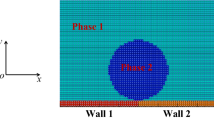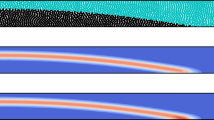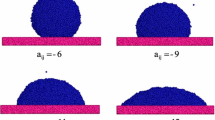Abstract
Numerical simulation of the morphology of a droplet deposited on a solid surface requires an efficient description of the three-phase contact line. In this study, a simple method of implementing the contact angle is proposed, combined with a robust smoothed particle hydrodynamics multiphase algorithm (Zhang 2015). The first step of the method is the creation of the virtual liquid–gas interface across the solid surface by means of dummy particles, thus the calculated surface tension near the triple point serves to automatically modulate the dynamic contact line towards the equilibrium state. We simulate the evolution process of initially square liquid lumps on flat and curved surfaces. The predictions of droplet profiles are in good agreement with the analytical solutions provided that the macroscopic contact angle is accurately implemented. Compared to the normal correction method, the present method is straightforward without the need to manually alter the normal vectors. This study presents a robust algorithm capable of capturing the physics of the static wetting. It may hold great potentials in bio-inspired superhydrophobic surfaces, oil displacement, microfluidics, ore floatation, etc.












Similar content being viewed by others
References
De Gans, B.J., Duineveld, P.C., Schubert, U.S.: Inkjet printing of polymers: state of the art and future developments. Adv. Mater. 16, 203–213 (2004)
Goldszal, A., Jacques, B.: Wet agglomeration of powders: from physics toward process optimization. Powder Technol. 117, 221–231 (2001)
Squires, T.M., Quake, S.R.: Microfluidics: fluid physics at the nanoliter scale. Rev. Mod. Phys. 77, 977–1026 (2005)
Sun, M., Luo, C., Xu, L., et al.: Artificial lotus leaf by nanocasting. Langmuir ACS J. Surf. Colloids. 21, 8978–8981 (2005)
Pate, J.S., Atkins, C.A., White, S.T., et al.: Nitrogen nutrition and xylem transport of nitrogen in ureide-producing grain legumes. Plant Physiol. 65, 961–965 (1980)
Gao, X., Jiang, L.: Biophysics: water-repellent legs of water striders. Nature 432, 36 (2004)
Nguyen, V.T., Park, W.G.: A volume-of-fluid (VOF) interface-sharpening method for two-phase incompressible flows. Comput. Fluids 152, 104–119 (2007)
Liu, G.R., Liu, M.B.: Smoothed Particle Hydrodynamics: A Meshfree Particle Method. World Scientific, Singapore (2003)
Zhang, Z.L., Ma, T., Liu, M.B., et al.: Numerical study on high velocity impact welding using a modified SPH method. Int. J. Comput. Methods (2018). https://doi.org/10.1142/S0219876218460015
Xu, A., Zhao, T.S., An, L., et al.: A three-dimensional pseudo-potential-based lattice Boltzmann model for multiphase flows with large density ratio and variable surface tension. Int. J. Heat Fluid Flow 56, 261–271 (2015)
Xu, A., Shyy, W., Zhao, T.: Lattice Boltzmann modeling of transport phenomena in fuel cells and flow batteries. Acta Mech. Sin. 33, 555–574 (2017)
Gingold, R.A., Monaghan, J.J.: Smoothed particle hydrodynamics: theory and application to non-spherical stars. Mon. Not. R. Astron. Soc. 181, 375–389 (1977)
Monaghan, J.J.: Simulating free surface flows with SPH. J. Comput. Phys. 110, 399–406 (1994)
Shao, J.R., Yang, Y., Gong, H.F., et al.: Numerical simulation of water entry with improved SPH method. Int. J. Comput. Methods (2018). https://doi.org/10.1142/S0219876218460040
Randles, P.W., Libersky, L.D.: Smoothed particle hydrodynamics: some recent improvements and applications. Comput. Methods Appl. Mech. Eng. 139, 375–408 (1996)
Hu, Y.X., Adams, N.A.: A multi-phase SPH method for macroscopic and mesoscopic flows. J. Comput. Phys. 213, 844–861 (2006)
Ming, F.R., Sun, P.N., Zhang, A.M.: Numerical investigation of rising bubbles bursting at a free surface through a multiphase SPH model. Meccanica 52, 2665–2684 (2017)
Zhang, A.M., Sun, P.N., Ming, F.R.: An SPH modeling of bubble rising and coalescing in three dimensions. Comput. Methods Appl. Mech. Eng. 294, 189–209 (2015)
Kunz, P., Zarikos, I.M., Karadimitriou, N.K., et al.: Study of multi-phase flow in porous media: comparison of SPH simulations with micro-model experiments. Transp. Porous Media 114, 581–600 (2016)
Zisi, I., Messahel, R., Boudlal, A., et al.: Validation of robust SPH schemes for fully compressible multiphase flows. Int. J. Multiphysics 9, 225–234 (2016)
Adami, S., Hu, X.Y., Adams, N.A.: A new surface-tension formulation for multi-phase SPH using a reproducing divergence approximation. J. Comput. Phys. 229, 5011–5021 (2010)
Szewc, K., Pozorski, J., Minier, J.P.: Simulations of single bubbles rising through viscous liquids using smoothed particle hydrodynamics. Int. J. Multiph. Flow 50, 98–105 (2013)
Shao, J.R., Li, S.M., Liu, M.B.: Numerical simulation of violent impinging jet flows with improved SPH method. Int. J. Comput. Methods 13, 1641001 (2016)
Nugent, S., Posch, H.A.: Liquid drops and surface tension with smoothed particle applied mechanics. Phys. Rev. E 62, 4968–4975 (2000)
Tartakovsky, A., Meakin, P.: Modeling of surface tension and contact angles with smoothed particle hydrodynamics. Phys. Rev. E 72, 026301 (2005)
Brackbill, J.U., Kothe, D.B., Zemach, C.: A continuum method for modeling surface tension. J. Comput. Phys. 100, 335–354 (1992)
Morris, J.P.: Simulating surface tension with smoothed particle hydrodynamics. Int. J. Numer. Methods Fluids 33, 333–353 (2000)
Liu, M.B., Liu, G.R.: Meshfree particle simulation of micro channel flows with surface tension. Comput. Mech. 35, 332–341 (2005)
Hu, Y.X., Adams, N.A.: A multi-phase SPH method for macroscopic and mesoscopic flows. J. Comput. Phys. 213, 844–861 (2006)
Das, A.K., Das, P.K.: Equilibrium shape and contact angle of sessile drops of different volumes—computation by SPH and its further improvement by DI. Chem. Eng. Sci. 65, 4027–4037 (2010)
Breinlinger, T., Polfer, P., Hashibon, A., et al.: Surface tension and wetting effects with smoothed particle hydrodynamics. J. Comput. Phys. 243, 14–27 (2013)
Yeganehdoust, F., Yaghoubi, M., Emdad, H., et al.: Numerical study of multiphase droplet dynamics and contact angles by smoothed particle hydrodynamics. Appl. Math. Model 40, 8493–8512 (2016)
de Gennes, P.G., Brochard-Wyart, F., Quere, D., et al.: Capillarity and Wetting Phenomena: Drops, Bubbles, Pearls, Waves. Springer (2004)
Bormashenko, E.: Young, Boruvka-Neumann, Wenzel and Cassie-Baxter equations as the transversality conditions for the variational problem of wetting. Colloids Surf. A 345, 163–165 (2009)
Dilts, G.A.: Moving least-squares particle hydrodynamics II: conservation and boundaries. Int. J. Numer. Methods Eng. 48, 1503–1524 (2000)
Acknowledgements
The work was supported by the National Natural Science Foundation of China (Grants 11672335 and 11611530541), China Postdoctoral Science Foundation (Grant 2017M622307), Shandong Natural Science Foundation (Grant ZR201709210320), Fundamental Research Funds for the Central Universities (Grant 18CX02153A), and the Endeavour Australia Cheung Kong Research Fellowship Scholarship from the Australian government.
Author information
Authors and Affiliations
Corresponding author
Appendix
Appendix
1.1 Detection of the triple contact points
Another critical step is the detection of the triple contact points. We propose the following procedures (see Fig. 13):
-
1.
Search for boundary particles belonging to the liquid and gas phases.
-
2.
Identify the lowest boundary particle close to the solid surface for both the gas and liquid phases, labeled as particles g and l.
-
3.
Determine mean coordinates for particles g and l as those for an intermediate point p. The projection of point p on the solid surface is then regarded as the triple contact point.
Following the method proposed by Dilts [35], the boundary particles can be detected by scanning the 3h radius (3h is the radius of the support domain) circle around an SPH particle. If the circle of the SPH particle is not completely covered by the circles of its neighbors, this particle is labeled as a boundary particle. Otherwise, it is an inner particle. By using this procedure, the position of the triple contact point can be accurately identified. However, it is relatively complex to implement, especially for three-dimensional cases. A simplified procedure can be realized through summarizing the fluid particles near the triple line, as shown in Fig. 14a.
We first calculate the averaged location of these particles, then project the point on the solid surface, and the projected point is identified as the triple contact point. We compare the results of the accurate method and simplified method, as shown in Fig. 14b. It shows that the results obtained by the simplified method match well with the accurate results. The simplified procedure is easy to implement and may be more workable for three-dimensional (3D) application.
Note that the position of the three-phase contact point is not constant and changes with the movement of the droplet, so the procedure must be carried out at each time step. The proposed method is implemented with no need of changing the original flow chart of the simulation.
Rights and permissions
About this article
Cite this article
Dong, X., Liu, J., Liu, S. et al. Quasi-static simulation of droplet morphologies using a smoothed particle hydrodynamics multiphase model. Acta Mech. Sin. 35, 32–44 (2019). https://doi.org/10.1007/s10409-018-0812-x
Received:
Revised:
Accepted:
Published:
Issue Date:
DOI: https://doi.org/10.1007/s10409-018-0812-x






